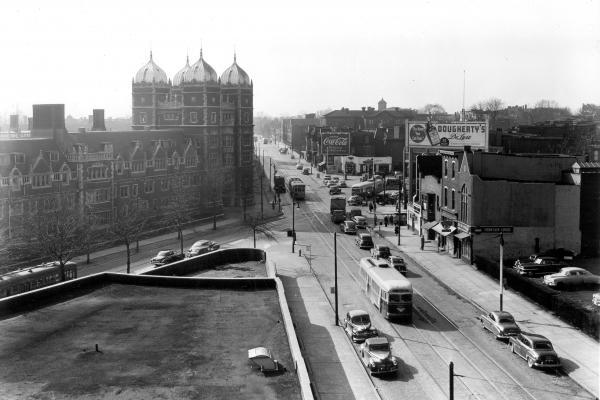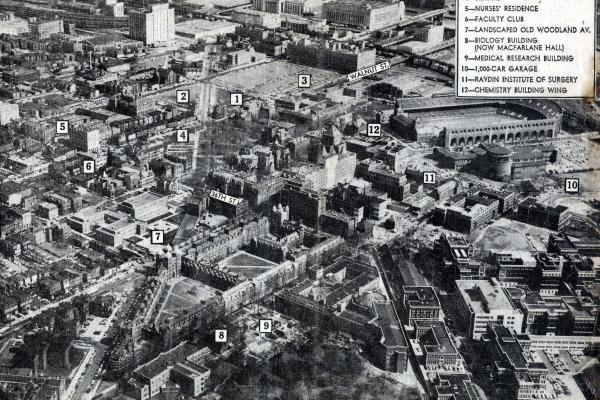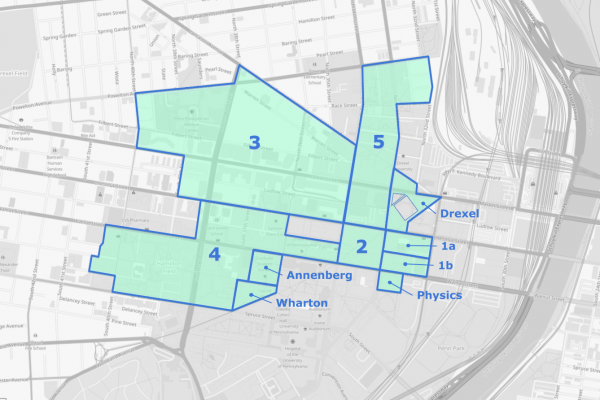This map, recreated from the Redevelopment Authority's 1965 Annual Report, represents the approximate boundaries of the major initiatives from 1948–1965.
As part of a wave of postwar urban renewal, the City of Philadelphia designated an 80-block area in eastern West Philadelphia for development by the University of Pennsylvania and the Drexel Institute (Drexel University).
Following World War II, major cities in the North and Midwest looked to their universities to serve as engines for revitalizing declining urban economies and as bulwarks against “blight,” a designation that city planners routinely and increasingly assigned to neighborhoods that were populated by poor and working-poor African Americans. Temple University, the University of Pennsylvania (Penn), and the Drexel Institute (Drexel) were the three Philadelphia higher education institutions whose boundary neighborhoods were targeted for urban renewal. In 1948, the Philadelphia City Planning Commission (PCPC) created the University Redevelopment Area in the eastern section of West Philadelphia. It was one of nine redevelopment areas in Philadelphia designated by the PCPC. Charged by Pennsylvania’s Urban Redevelopment Law of 1946 to oversee the details of urban renewal plans (subject to approval by the PCPC and City Council), Philadelphia’s Redevelopment Authority (RDA) divided the university planning area into five units. The units were distributed between the Drexel Institute and the University of Pennsylvania to expand their campuses. Bolstered by federal, state, and city funds, the RDA invoked eminent domain, condemned and bulldozed buildings, relocated residents, and sold the leveled properties to the institutions at a rate well below their market value.
Continue reading Urban Renewal in West Philadelphia
Stories in this Collection
 1952–1970 In the 1950s, Penn’s campus planning was closely aligned with the City Planning Commission’s urban renewal plans for the University Redevelopment Area. The City first built a subway-extension tunnel and located the Penn trolleys underground; next, upon acquiring Woodland Avenue from the Pennsylvania General Assembly, the City deeded the roadbed to Penn. Near the end of the decade, the University acquired two urban renewal planning units from the Redevelopment Authority, then split one of them with the Drexel Institute of Technology. |
 1948–1977 In the 1960s, Penn’s campus expansion west and north of the historic core around College Hall was served through the eminent-domain activity of the Redevelopment Authority in Unit 4. The University received urban renewal building funds from the Pennsylvania General State Authority and the state’s Higher Education Facilities Authority, the latter agency helping to build the West Campus’s superblock of high-rise dormitories. Section 112 of the Federal Housing Act of 1959 gave urban universities wide latitude to redevelop commercial properties in the immediate campus area—in Penn’s case, Walnut Street. |
1957–1964 Alarmed that the Philadelphia Redevelopment Authority (RDA) earmarked all of University Redevelopment Area's Unit 1 for the University of Pennsylvania’s campus expansion, Drexel Institute of Technology’s president James Creese filed a grievance with City Council in 1957. The RDA’s coupling of Units 1 and 2 would have given Penn urban renewal rights to the entire quadrant bounded by Walnut and Chestnut from 32nd to 34th Streets. Under pressure from City Council, Penn reached an agreement with Drexel that divided Unit 1 between the two institutions, giving Drexel redevelopment (i.e., campus-expansion) rights to Unit 1B, and positioning the Institute cheek-by-jowl with Penn. |
 1964–1977 The Philadelphia Redevelopment Authority created Unit 5 of the University Redevelopment Area in 1961, with Drexel as the designated redeveloper. Drexel commissioned the firm of Nolen & Swinburne to design a master plan (called the 1970 Plan, it was completed in 1964), which projected Drexel’s campus expansion into Powelton Village. As construction of the 1970 Plan’s first building, Kelly Hall, Drexel’s first men’s dormitory, proceeded in 1965, the Institute and the Philadelphia Redevelopment Authority were at loggerheads with the Powelton Civic Homeowners Association. Other community battles over dormitory placements would follow in the coming decade and disrupt Drexel’s timetable for campus expansion. After the 1970s, community protests abated as Drexel, now a university, slowed its expansion in the face of a mounting financial crisis. |
 1958–1970 University Redevelopment Area Unit 3 (RDA Unit 3), centered around Market Street between 34th and 40th Streets, was certified for redevelopment in the late 1960s. The developer, the West Philadelphia Corporation (WPC), planned the area for the University City Science Center. The WPC, a coalition funded and run primarily by the University of Pennsylvania, saw the Science Center as the centerpiece of their conception of the scholarly urban oasis branded "University City." The Drexel Institute (Drexel) was another WPC member (and therefore also involved in the construction of the Science Center), but held limited stakes and interest in the project. Before redevelopment, RDA Unit 3 was a residential area and the construction of the Science Center displaced over 2,000 residents, primarily African American renters. |

